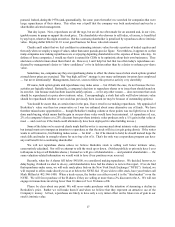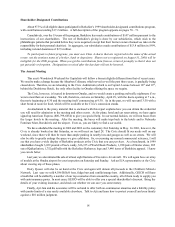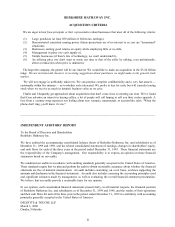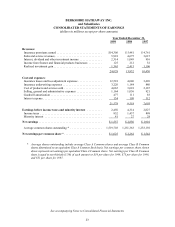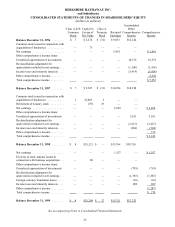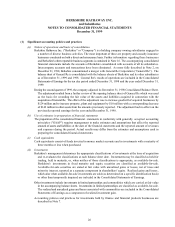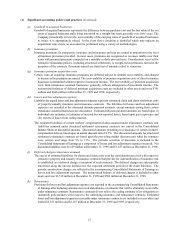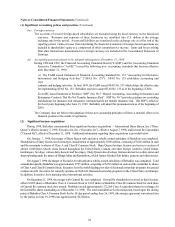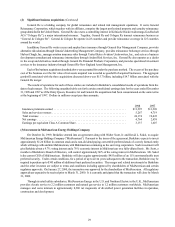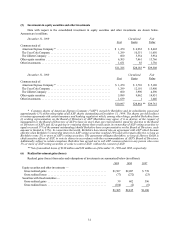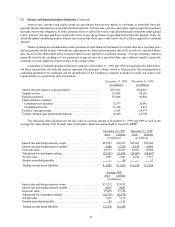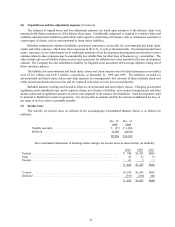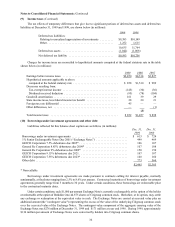Berkshire Hathaway 1999 Annual Report Download - page 28
Download and view the complete annual report
Please find page 28 of the 1999 Berkshire Hathaway annual report below. You can navigate through the pages in the report by either clicking on the pages listed below, or by using the keyword search tool below to find specific information within the annual report.27
(1) Significant accounting policies and practices (Continued)
(e) Goodwill of acquired businesses
Goodwill of acquired businesses represents the difference between purchase cost and the fair value of the net
assets of acquired businesses and is being amortized on a straight line basis generally over forty years. The
Company periodically reviews the recoverability of the carrying value of goodwill of acquired businesses
to insure it is appropriately valued. In the event that a condition is identified which may indicate an
impairment issue exists, an assessment is performed using a variety of methodologies.
(f) Insurance premiums
Insurance premiums for prospective insurance and reinsurance policies are earned in proportion to the level
ofinsurance protection provided. In most cases, premiums are recognized as revenues ratably over their
terms with unearned premiums computed on a monthly or daily pro rata basis. Consideration received for
retroactive reinsurance policies, including structured settlements, is recognized as premiums earned at the
inception of the contracts. Premiums earned are stated net of amounts ceded to reinsurers.
(g) Insurance premium acquisition costs
Certain costs of acquiring insurance premiums are deferred, subject to ultimate recoverability, and charged
to income as the premiums are earned. The recoverability of premium acquisition costs of direct insurance
businesses is determined without regard to investment income. The recoverability of premium acquisition
costs from reinsurance assumed businesses, generally, reflects anticipation of investment income. The
unamortized balances of deferred premium acquisition costs are included in other assets and were $791
million and $666 million at December 31, 1999 and 1998, respectively.
(h) Losses and loss adjustment expenses
Liabilities for unpaid losses and loss adjustment expenses represent estimated claim and claim settlement costs
of property/casualty insurance and reinsurance contracts. The liabilities for losses and loss adjustment
expenses are recorded at the estimated ultimate payment amounts, except amounts arising from certain
reinsurance assumed businesses are discounted. Estimated ultimate payment amounts are based upon (i)
individual case estimates, (ii) estimates of incurred-but-not-reported losses, based upon past experience and
(iii) reports of losses from ceding insurers.
The estimated liabilities of certain workers’ compensation claims assumed under reinsurance contracts and
liabilities assumed under structured settlement reinsurance contracts are carried in the Consolidated
Balance Sheets at discounted amounts. Discounted amounts pertaining to reinsurance of certain workers’
compensation risks are based upon an annual discount rate of 4.5%. The discounted amounts for structured
settlement reinsurance contracts are based upon the prevailing market discount rates when the contracts
were written and range from 5% to 13%. The periodic accretion of discounts is included in the
Consolidated Statements of Earnings as a component of losses and loss adjustment expenses incurred. Net
discounted liabilities were $1,529 million at December 31, 1999 and $1,637 million at December 31, 1998.
(j) Deferred charges-reinsurance assumed
The excess of estimated liabilities for claims and claim costs over the consideration received with respect to
retroactive property and casualty reinsurance contracts that provide for indemnification of insurance risk
is established as a deferred charge at inception of such contracts. The deferred charges are subsequently
amortized using the interest method over the expected settlement periods of the claim liabilities. The
periodic amortization charges are reflected in the accompanying Consolidated Statements of Earnings as
losses and loss adjustment expenses. The unamortized balance of deferred charges is included in other
assets and was $1,518 million at December 31, 1999 and $560 million at December 31, 1998.
(k) Reinsurance
Provisions for losses and loss adjustment expenses are reported in the accompanying Consolidated Statements
of Earnings after deducting amounts recovered and estimates of amounts that will be ultimately recoverable
under reinsurance contracts. Reinsurance contracts do not relieve the ceding company of its obligations to
indemnify policyholders with respect to the underlying insurance and reinsurance contracts. Estimated
losses and loss adjustment expenses recoverable under reinsurance contracts are included in receivables and
totaled $2,331 million and $2,167 million at December 31, 1999 and 1998, respectively.


